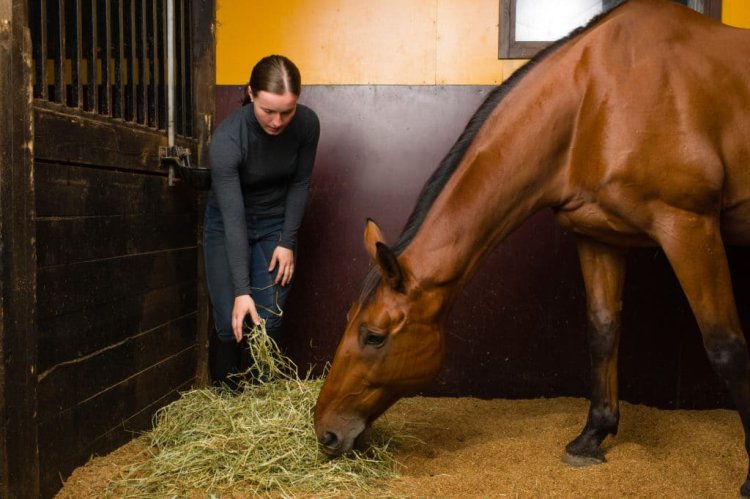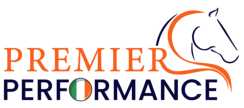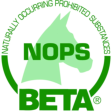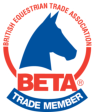in basket
TOP OFFER - SUMMER20 - 20% OFF and 4 FREE seasonal products!
10 Rules of feeding your horse and why

1. Feed your horse little and often
This rule is important for a few reasons. Firstly, you may recall from my previous articles that a horse’s digestive system is designed to process food on an almost continual basis. Consequently, the horse has a relatively small stomach for its size and also the small intestine, where enzymatic digestion of protein, starch, sugars and fats takes place, has a limited ability to digest starch. This means that if you feed your horse a large bucket full of feeds that are high in starch; for example cereal grains (oats, barley, maize) or a concentrate mix that contains high levels of starch, then some of the starch will bypass digestion in the small intestine and it will enter the hindgut where it will be rapidly fermented by the microbes. If a lot of starch reaches the horse’s hindgut then this can cause a disturbance to the microbial populations and may reduce the pH, which can also lead to reduced fibre digestion and, in some cases, colic. As a rule, a 500kg horse should not be fed more than 2kg of a feed containing 25% starch in one meal. 2kg of a feed containing 25% starch equates to 500g of starch in that one meal. The guidance is that horses should receive no more that 1g of starch per kg bodyweight per meal, which is 500g for a 500kg horse.
Another reason for feeding little and often relates back to the fact that horses only produce saliva as a direct result of chewing, which means that the amount of saliva produced is proportional to the amount of chewing. Saliva is extremely important for maintaining a healthy stomach (see gastric health article) and therefore it is very important that horses have access to forage or pasture on almost continual basis and not be fasted for anymore than 3 hours at a time. From a welfare point of view, horses are instinctively motivated to chew and if they are left without forage for significant amounts of time then this can result in stress and the possible development of stereotypic behaviours, such as crib-biting.
2. Feed your horse plenty of roughage / fibre
In addition to what I have discussed in the previous point related to the importance of forage in your horse’s diet, another aspect is the hindgut. In contrast to the small intestine, digestion and absorption in the hindgut is dependent on microbial fermentation of undigested feed residues leaving the small intestine, the main end-products of which are the volatile fatty acids (VFA); acetate, propionate and butyrate, and the gases carbon dioxide (CO2) and methane (CH4). The VFAs that are produced as a by-product of fermentation are then absorbed across the gut wall and are used as an important energy source by the horse. Structural carbohydrates, i.e. those associated with the plant cell wall (fibrous fraction of the plant), undergo microbial fermentation in the large intestine as the horse lacks the endogenous enzymes required to digest these plant constituents. In fact, the hindgut is designed to digest fibre and it is when non-fibrous substrates, such as starch and fructan enter, that problems can arise.
3. Feed your horse according to size, weight, condition, age, breed, temperament and work done
A horse’s appetite is somewhere between 1.5% and 3.5% of bodyweight if they are left to their own devices and fed ad lib. In terms of calculating how much food to give your horse each day, the general guidance is 2% of their bodyweight, which is 10kg for a 500kg horse. It is important to be aware that the 10kg is the amount of dry matter the horse eats, which is the amount of food minus any water content. For example, grass hay contains around 15% water and 85% dry matter, whilst fresh grass contains around 80% water and 20% dry matter. Therefore, if you were feeding your 500kg horse hay only then you would provide 11.8kg of what is called fresh matter to meet the dry matter requirement of 10kg (10 divided by 0.85). The condition of your horse is also important, and we assess this through what is called body condition scoring (BCS), which essentially measures fat accumulation in horses. This is done using a BCS scale and the one I use is the 1-9 point scale, which measures fat disposition at 6 areas of the horse’s body and uses a scale of 1-9 to assess each area.
Further information on body condition scoring can be found here:
https://thehorse.com/164978/body-condition-scoring-horses-step-by-step/.
When calculating nutrient requirements, breed and temperament are also important consideration, particularly in relation to energy intakes. It is recognised that certain breeds of horses, generally the native breeds, require less calories to maintain weight that other breeds such as the thoroughbred. In part, this is also related to temperament as it is known that native breeds are generally less self-active and therefore burn less calories at maintenance. However, the temperament of these breeds also needs to be considered in relation to the type of energy provided as it is also well documented that feeds containing starch can increase “reactive” behaviour in horses. Unfortunately, this reactive behaviour is not exerted in more forwardness, which is why you can’t feed your horse to be more forward going but results in more less-desirable behaviours reactive behaviours, such as spooking.
Age also affects feed requirements; for example, growing horses have different requirements to adult mature horses and the amount and type of work your horse is doing also impacts on nutrient requirements. In growing horses that are also in work, then these requirements are even higher.
4. Increase you horse's feed quantity and energy content according to level of work done
This rule relates to the amount of nutrient provided in your horse’s diet. For example, if you overfeed the number of calories your horse requires then s/he will gain weight and vice versa. If your horse is in light work, then it is important to get the amount of energy s/he requires correct. If you feed even a little extra everyday then this can add up over time. For example, if you feed a handful of a “leisure” mix each day as an extra this can result in your horse increasing a whole BCS point over a year.
5. Any changes to you horse's feeding should be made gradually
The microbes in your horse’s hindgut need time to adapt to new feeds, but also if your horse has not been fed any concentrates containing starch then the enzymes in the small intestine that digest the starch (known as amylases) take time to increase. It can take up to one month for the amylases in the small intestine to increase. Also, research has shown that horses fed high-starch concentrates are at a greater risk of developing colic compared with those that are not. Moreover, this risk increases with the amount of concentrates fed. Horses that have their diet changed abruptly are at much greater risk of developing colic than those where the change has taken place gradually over a period of two to four weeks.
6. Feed your horse at the same time each day
Horses are creatures of habit and thrive on routine. They have excellent internal clocks and are great timekeepers. Thus, it is best to keep to a feeding schedule and routine. Whilst a change in feeding routine may not be harmful to the majority of horses, it is advisable to avoid sudden changes in horses that are prone to colic as this may increase the risk of another colic episode.
7. Feed your horse good quality feeds
In previous articles I have talked about the horse’s gut having evolved to digest low-nutritional quality feedstuffs. However, feeds can be of low nutritional quality, which may be entirely appropriate if, for example, your horse needs to lose weight, but feeds should never be of low hygienic quality. Hygienic quality refers to factors that may have a negative impact on preservation of the food (in terms of hay or haylage) or to the health and wellbeing of the animal. For example, it is important that the feed is free (in so far as possible) from dust, insects or mould.
8. Keep your horse's feed and water buckets clean
We often put a great deal of thought into what we feed our horses, but we sometimes overlook what buckets we are feeding them in and in particular the cleanliness of feed buckets and tubs. Whilst your horse is unlikely to bother about how clean these are, they can build up residue and therefore should be cleaned at least twice a week. However, water bucket/tubs and drinkers should be cleaned every day. Keeping feed and water buckets clean is important to avoid any contamination or growth of undesirable organisms that can impact on you and your horse’s health.
9. Ensure your horse has clean, fresh water available at all times
Water is an essential component of your horse’s diet; 65 to 75% of an adult horse and 80% of a foal’s bodyweight is comprised of water. Water is required for a number of life-supporting functions, including digestion and thermoregulation. Therefore, it’s important to ensure horses have access to water at all times and a plentiful supply especially in hot weather. Most horse owners do provide free access to water, but it’s also important to ensure that the water is clean and palatable. On average a horse will drink approximately 5% of its bodyweight per day, which is 25 litres in a 500kg horse. However, water requirements depend on your horse’s age, level of exercise, environmental conditions (temperature and humidity) and the type for feed they eat (horses drink more on feeds that are dry, such as hay).
10. Don’t exercise your horse directly after feeding or feed directly after exercise
Avoid feeding large amounts of concentrates prior to riding and allow one to two hours after feeding before starting exercise. Likewise, don’t feed immediately after exercise, again allow one to two hours before feeding. During exercise, blood is diverted to the muscles and lungs and digestion is slowed as a consequence; thus, a large meal before exercise can increase the risk of colic developing. Equally, ensure your horse has completely cooled down after exercise before feeding any concentrates, again to avoid any gastrointestinal disturbance.
Article written for Premier Performance by Professor Jo-Anne Murray.






